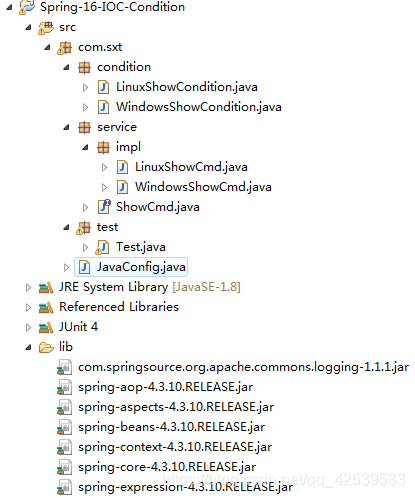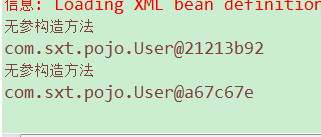条件注解
Profile实际上就是条件注解的一种特殊形式,即条件注解更加灵活,用户可以根据各种不同的条件使用不同的Bean。
条件注解在SpringBoot中使用非常广泛。SpringBoot中提供了许多自动化的配置,例如数据库配置,SpringBoot使用条件注解提前配置好许多常用的类,使用条件注解,在某一个条件满足时,这些配置就会生效
1.创建接口
package com.sxt.service;
public interface ShowCmd {
public String show();
}
2.创建接口的实现类
package com.sxt.service.impl;
import com.sxt.service.ShowCmd;
public class WindowsShowCmd implements ShowCmd {
@Override
public String show() {
System.out.println("windows:dir");
return "dir";
}
}
package com.sxt.service.impl;
import com.sxt.service.ShowCmd;
public class LinuxShowCmd implements ShowCmd {
@Override
public String show() {
System.out.println("linux:ls");
return "ls";
}
}
3.定义条件Condition
package com.sxt.condition;
import org.springframework.context.annotation.Condition;
import org.springframework.context.annotation.ConditionContext;
import org.springframework.core.type.AnnotatedTypeMetadata;
public class WindowsShowCondition implements Condition{
/**
* 匹配条件
* @return
* true 匹配
* false 不匹配
*/
@Override
public boolean matches(ConditionContext cc, AnnotatedTypeMetadata atm) {
String[] profiles = cc.getEnvironment().getActiveProfiles();
for (String p : profiles) {
if (p.contains("windows")) {
return true;
}
}
return false;
}
}
package com.sxt.condition;
import org.springframework.context.annotation.Condition;
import org.springframework.context.annotation.ConditionContext;
import org.springframework.core.type.AnnotatedTypeMetadata;
public class LinuxShowCondition implements Condition{
/**
* 匹配条件
* @return
* true 匹配
* false 不匹配
*/
@Override
public boolean matches(ConditionContext cc, AnnotatedTypeMetadata atm) {
String[] profiles = cc.getEnvironment().getActiveProfiles();
for (String p : profiles) {
if (p.contains("linux")) {
return true;
}
}
return false;
}
}
4.java配置文件
package com.sxt;
import org.springframework.context.annotation.Bean;
import org.springframework.context.annotation.Conditional;
import org.springframework.context.annotation.Configuration;
import com.sxt.condition.LinuxShowCondition;
import com.sxt.condition.WindowsShowCondition;
import com.sxt.service.ShowCmd;
import com.sxt.service.impl.LinuxShowCmd;
import com.sxt.service.impl.WindowsShowCmd;
@Configuration
public class JavaConfig {
@Bean
@Conditional(WindowsShowCondition.class)
public ShowCmd windowsShowCmd(){
return new WindowsShowCmd();
}
@Bean
@Conditional(LinuxShowCondition.class)
public ShowCmd linuxShowCmd(){
return new LinuxShowCmd();
}
}
5.测试调用
package com.sxt.test;
import org.springframework.context.annotation.AnnotationConfigApplicationContext;
import com.sxt.JavaConfig;
import com.sxt.service.ShowCmd;
public class Test {
public static void main(String[] args) {
AnnotationConfigApplicationContext ac = new AnnotationConfigApplicationContext();
ac.getEnvironment().setActiveProfiles("linux");
ac.register(JavaConfig.class);
ac.refresh();
ShowCmd bean = ac.getBean(ShowCmd.class);
System.out.println(bean.show());
}
}

Bean的作用域

在spring的配置中,默认情况下,bean都是单例的(singleton)。无论获取多少次,获取到的都是同一个bean
User类
package com.sxt.pojo;
public class User {
public void run(){
System.out.println("run方法");
}
public User() {
System.out.println("无参构造方法");
}
}
配置文件
<?xml version="1.0" encoding="UTF-8"?>
<beans xmlns="http://www.springframework.org/schema/beans"
xmlns:xsi="http://www.w3.org/2001/XMLSchema-instance"
xsi:schemaLocation="http://www.springframework.org/schema/beans
http://www.springframework.org/schema/beans/spring-beans.xsd">
<!-- 注册user对象 scope:默认singleton-->
<bean class="com.sxt.pojo.User" scope="prototype" />
</beans>
测试
package com.sxt.test;
import org.junit.Test;
import org.springframework.context.ApplicationContext;
import org.springframework.context.support.ClassPathXmlApplicationContext;
import com.sxt.pojo.User;
public class IocTest {
@Test
public void test(){
//加载spring容器
ApplicationContext ac = new ClassPathXmlApplicationContext("applicationContext.xml");
//从spring容器中获取User对象
User user = ac.getBean(User.class);
System.out.println(user);
user = ac.getBean(User.class);
System.out.println(user);
}
}



混合配置
开发中可能既有配置文件存在,也在使用java配置的方式,这时候可以使用@ImportResource来实现
applicationContext.xml
<beans xmlns="http://www.springframework.org/schema/beans"
xmlns:xsi="http://www.w3.org/2001/XMLSchema-instance" xmlns:p="http://www.springframework.org/schema/p"
xmlns:context="http://www.springframework.org/schema/context"
xsi:schemaLocation="http://www.springframework.org/schema/beans http://www.springframework.org/schema/beans/spring-beans.xsd
http://www.springframework.org/schema/context http://www.springframework.org/schema/context/spring-context-4.3.xsd">
<bean class="com.dpb.javabean.UserBean" ></bean>
</beans>
java配置文件
@Configuration
@ImportResource("classpath:application.xml")
public class AppJavaConfig {
@Bean
Book book(){
return new Book();
}
}
版权声明:本文为qq_42539533原创文章,遵循CC 4.0 BY-SA版权协议,转载请附上原文出处链接和本声明。